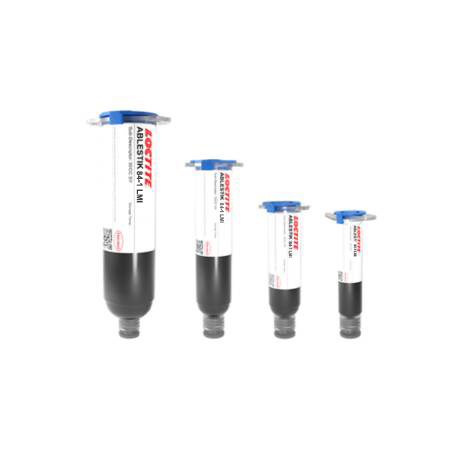LOCTITE ABLESTIK 84-1LMI
- Low bleed
- Low outgassing
- Electrically conductive
Product Description
LOCTITE ABLESTIK 84-1LMI epoxy die attach adhesive is designed for microelectronic chip bonding applications. This rigid adhesive is ideal for application by automatic dispenser or hand probe. It can be used on Noble metals and offers excellent mechanical and chemical strength. This product, just as its close relative 84-1LMISR4 are designed for stencil printing.
LOCTITE ABLESTIK 84-1LMI is a highly electrically conductive, silver filled adhesive with low bleed and low outgassing that meets the requirements of MIL-STD883, Method 5011. This product long work life and high reliability across industries and is typically used for component and die attach for the military, automotive, industrial and semiconductor sector. Its operating temperature is -40 up to 150°C.
Cure Schedule
- 1 hour @ 150°C
- 2 hours @ 125°C
Technical Specifications
| General Properties | |||||||||
| |||||||||
| |||||||||
| Work life @25°C Work life @25°C Work life is the amount of time we have to work with a material until it is no longer able to be easily worked and applied on a substrate. It is based on the change in viscosity and it can rely on the application requirements. | 336 hours | ||||||||
| Physical Properties | |||||||||
| Thixotropic index Thixotropic index Thixotropic Index is a ratio of a material s viscosity at two different speeds in Ambient temperature, generally different by a factor of ten. A thixotropic material s viscosity will decrease as agitation or pressure is increased. It indicates the capability of a material to hold its shape. Mayonnaise is a great example of this. It holds its shape very well, but when a shear stress is applied, the material easily spreads. It helps in choosing a material in accordance to the application, dispense method and viscosity of a material. | 4.0 | ||||||||
| Viscosity Viscosity Viscosity is a measurement of a fluid’s resistance to flow. Viscosity is commonly measured in centiPoise (cP). One cP is defined as the viscosity of water and all other viscosities are derived from this base. MPa is another common unit with a 1:1 conversion to cP. A product like honey would have a much higher viscosity -around 10,000 cPs- compared to water. As a result, honey would flow much slower out of a tipped glass than water would. The viscosity of a material can be decreased with an increase in temperature in order to better suit an application | 30,000 mPa.s | ||||||||
| Chemical Properties | |||||||||
| |||||||||
| Mechanical Properties | |||||||||
| |||||||||
| Electrical Properties | |||||||||
| Volume Resistivity Volume Resistivity Volume resistivity, also called volume resistance, bulk resistance or bulk resistivity is a thickness dependent measurement of the resistivity of a material perpendicular to the plane of the surface. | 5.0x10-4 Ohms⋅cm | ||||||||
| Thermal Properties | |||||||||
| |||||||||
| Glass Transition Temperature (Tg) Glass Transition Temperature (Tg) The glass transition temperature for organic adhesives is a temperature region where the polymers change from glassy and brittle to soft and rubbery. Increasing the temperature further continues the softening process as the viscosity drops too. Temperatures between the glass transition temperature and below the decomposition point of the adhesive are the best region for bonding. The glass-transition temperature Tg of a material characterizes the range of temperatures over which this glass transition occurs. | 103 °C | ||||||||



